Research on Inclined Granular Flows in the Sibley School
The flows of grains down rough inclined planes ("chutes") have served as a model for geophysical phenomena such as rock slides, dunes and avalanches. They are also used in passive industrial solids conveying of ores and grains. Delannay, et al distinguish three principal categories of grains flows on inclines, depending whether the base is rough, flat-frictional, or erodible.
At Cornell, we have conducted research on all three flow categories with a combination of experiments, theory, and numerical simulations. We have also designed instruments specifically for these flows.
News
As Associate Editor of the Journal of Geophysical Research-Earth Surface, Michel Louge was invited to write a commentary on "The reduction of friction in long-runout landslides as an emergent phenomenon" by Brandon C. Johnson, Charles S. Campbell, and H. Jay Melosh:
Commentary abstract: Johnson et al. (2016) use numerical simulations of disks to revisit the mystery of the struzstrom, a kind of landslide that travels an unexpectedly long distance on flat land, far beyond the mountain slope on which it initially accelerated.
Abstract of Johnson, et al (2016): Campbell et al. (1995) modeled long runout landslides as granular flow using a soft particle code. Their model essentially simulates landslides from first principles, and although no fluid or obvious mechanism for reduction of friction is included, the model successfully reproduced many field observations of landslides (e.g., the preservation of source stratigraphy in the final slide mass and a decreasing effective friction with increasing slide volume). We extend the work of Campbell et al. (1995) with a focus on the mechanism that reduces friction in these slides. We find sliding preferentially occurs when the overburden is relieved by pressure variations in the slide. Further analysis shows that our results are very similar to the predictions of the acoustic fluidization hypothesis. Moreover, we determine that for long runout landslides the wavelength of vibrations associated with acoustic fluidization is determined by the size of the rock fragments in the slide.
Here are links to Michel Louge's webcast seminar, presentation and abstract at the Isaac Newton Institute for Mathematical Sciences for the 2nd IMA conference on Dense Granular Flows on July 1, 2013.
Alexandre Valance and Michel Louge co-edited a special issue of Compte-Rendus Physique, the journal of the French Academy of Sciences, on Granular Physics. The issue covered many relevant topics: Farhang Radjai on "Modeling force transmission in granular materials", Bob Behringer on "Jamming in granular materials", Jacques Desrues and Edward Ando on "Strain localisation in granular media", Martin van Hecke on "Slow granular flows", Renaud Delannay, Mickael Duranteau and Vincent Tournat on "Precursors and triggering mechanisms of granular avalanches", V. Kumaran on "Kinetic theory for sheared granular flows", Pierre Jop on "Rheological properties of dense granular flows", Nico Gray, Parmesh Gajjar and Peter Kokelaar on "Particle-size segregation in dense granular avalanches", Barbara Turnbull, Elisabeth Bowman and Jim McElwaine on "Debris flows", Betty Sovilla, Jim McElwaine and Michel Louge on "The structure of powder snow avalanches", Alexandre Valance, Keld Rasmussen, Ahmed Ould El Moctar and Pascal Dupont on "The physics of Aeolian sand transport", and Sylvain Courrech du Pont on "Dune morphodynamics".
Here is a presentation at
the Second International Granular Flow Workshop in Guiyang, China,
Tuesday, August 22, 2017, showing the importance of boundary conditions
on granular flows down inclines.
Results
Our main publications on this subject include:
Louge, M. Y., A. Valance, P. Lancelot, R. Delannay, and O. Artieres (2015) Granular flows on a dissipative base, Phys Rev. E 92, 022204, 1-9 (available under the terms of the Creative Commons Attribution 3.0 License).
We study inclined channel flows of sand over a sensor-enabled
composite geotextile fabric base that dissipates granular fluctuation
energy. We record strain of the fabric along the flow direction with
imbedded fiber-optic Bragg gratings, flow velocity on the surface by
correlating grain position in successive images, flow thickness with
the streamwise shift of an oblique laser light sheet, velocity depth
profile through a transparent side wall using a high-speed camera, and
overall discharge rate. These independent measurements at inclinations
between 33° and 37° above the angle of repose at 32.1+/-0.8° are
consistent with a mass flow rate scaling as the 3/2 power of the flow
depth, which is markedly different than flows on a rigid bumpy
boundary. However, this power changes to 5/2 when flows are forced on
the sand bed below its angle of repose. Strain measurements imply that
the mean solid volume fraction in the flowing layer above the angle of
repose is 0.268+/- 0.033, independent of discharge rate or inclination.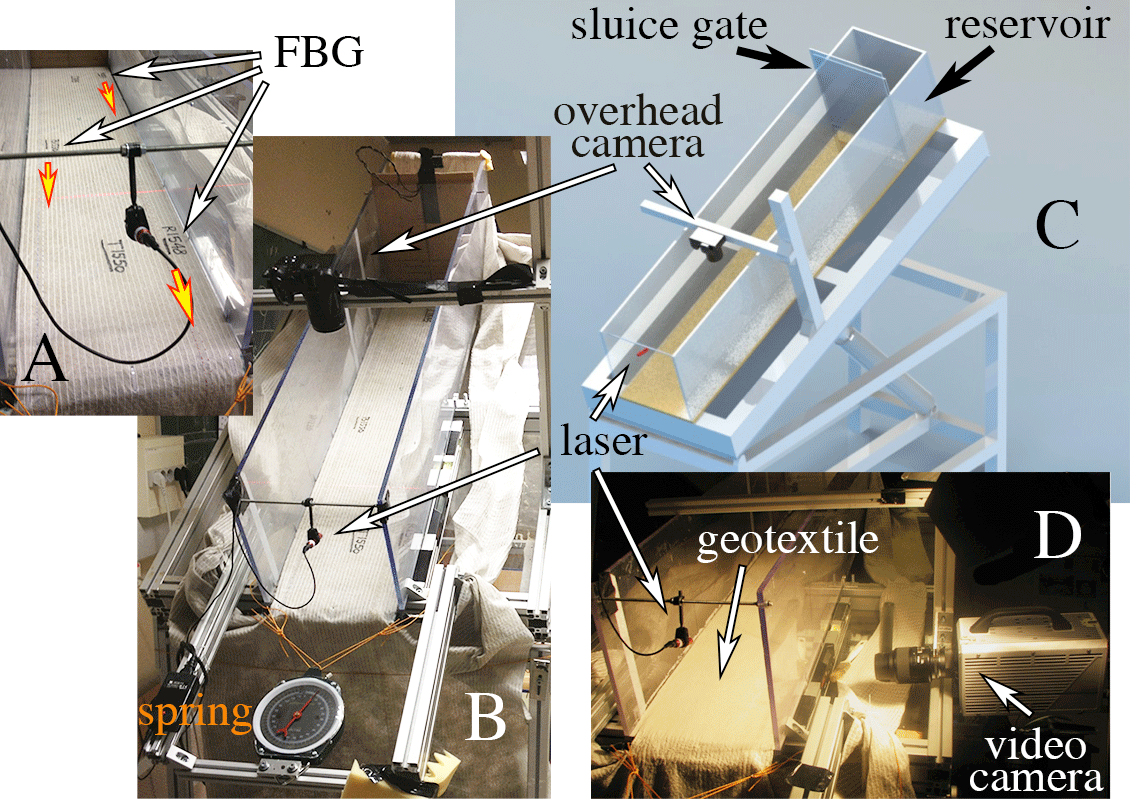
Apparatus (A) Position and orientation of the three FBGs. (B) Overview showing the bare geotextile laid at the base of the channel and the spring that tensions it at the exit. (C) Sketch showing reservoir, sluice gate, laser profiler and overhead camera. (D) Detail near the exit showing the high-speed video camera trained to observe the flow through one of the transparent side walls.
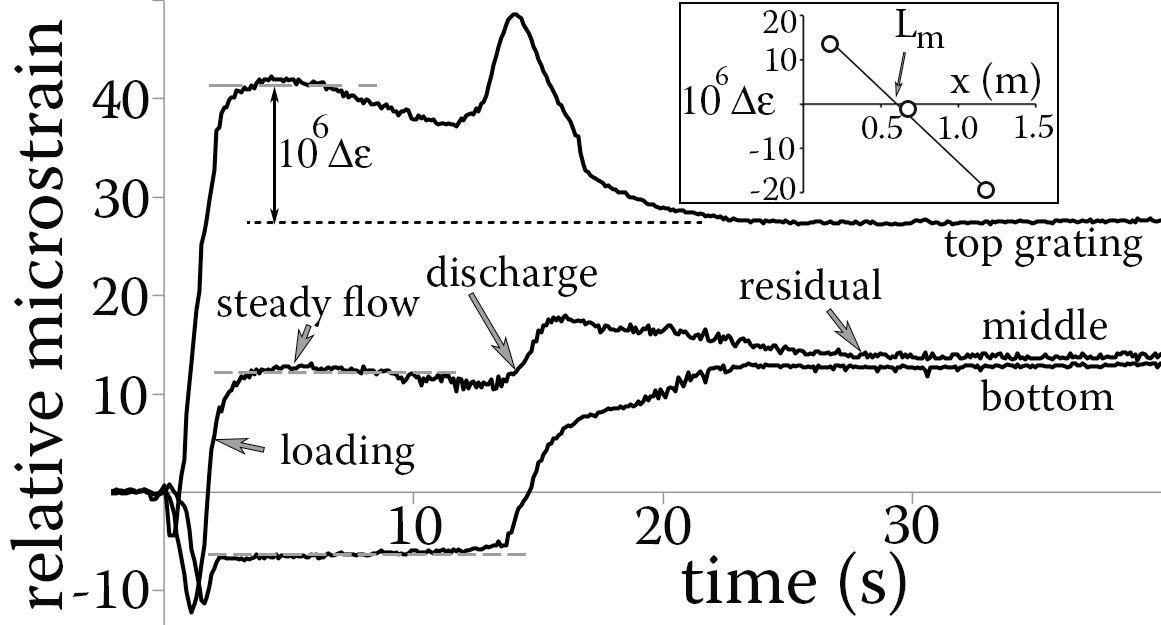
Typical microstrain time histories from the top, middle and bottom fiber Bragg gratings (FBG). The abscissa is time in seconds after opening the sluice gate. The ordinate is 10^6 x strain, translated to superimpose the three signals for t < 0. The loading, steady flow, and discharge phases are marked on the signal of the middle FBG, along with its residual strain after the flow stops. Grey dashed lines show the period of steady strain, lasting at least 4s. The microstrain differences between these steady plateaus are plotted in
the inset vs FBG distance to the upstream geotextile anchor in meters.
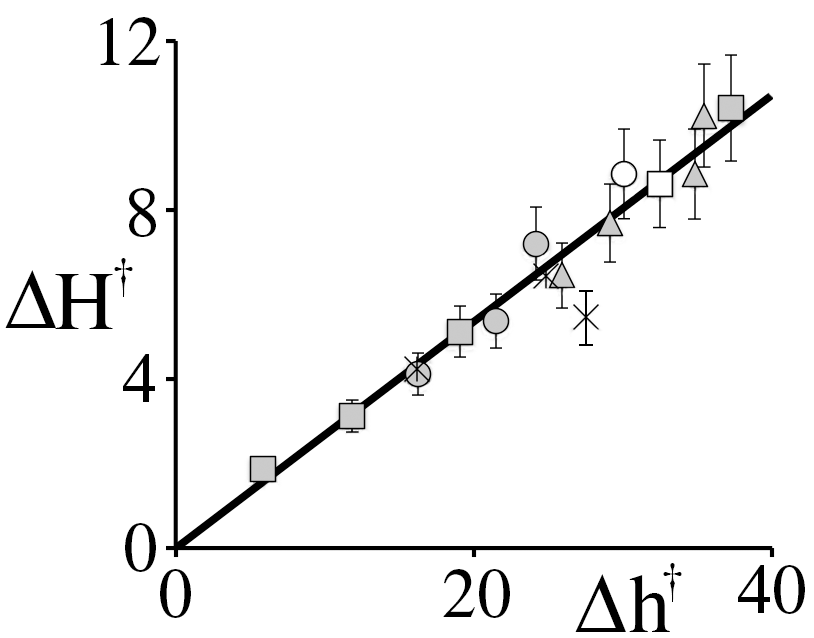
Dimensionless mass hold-up in the flowing layer vs dimensionless flow depth. The slope is the mean solid volume fraction 0.268.
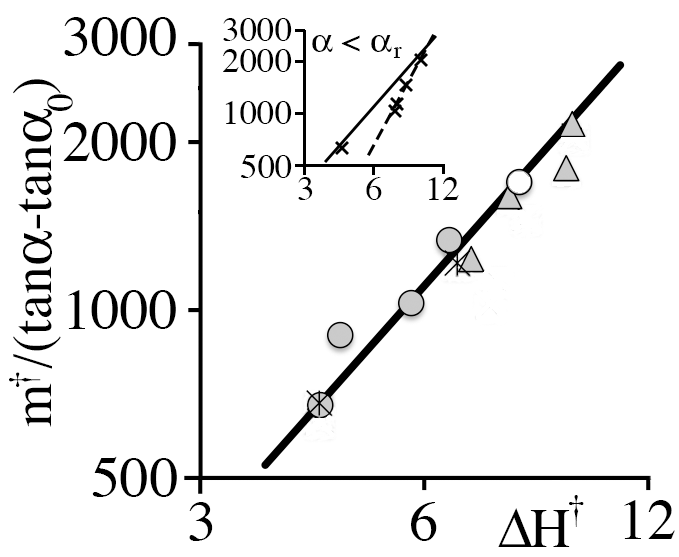
Dimensionless discharge mass flow rate vs dimensionless mass hold-up in the flowing layer. The main graph is for inclinations steeper than the angle of repose. The inset is for 31° < angle of repose. The solid line is inclined at a 3/2 slope and the dashed line at 5/2.
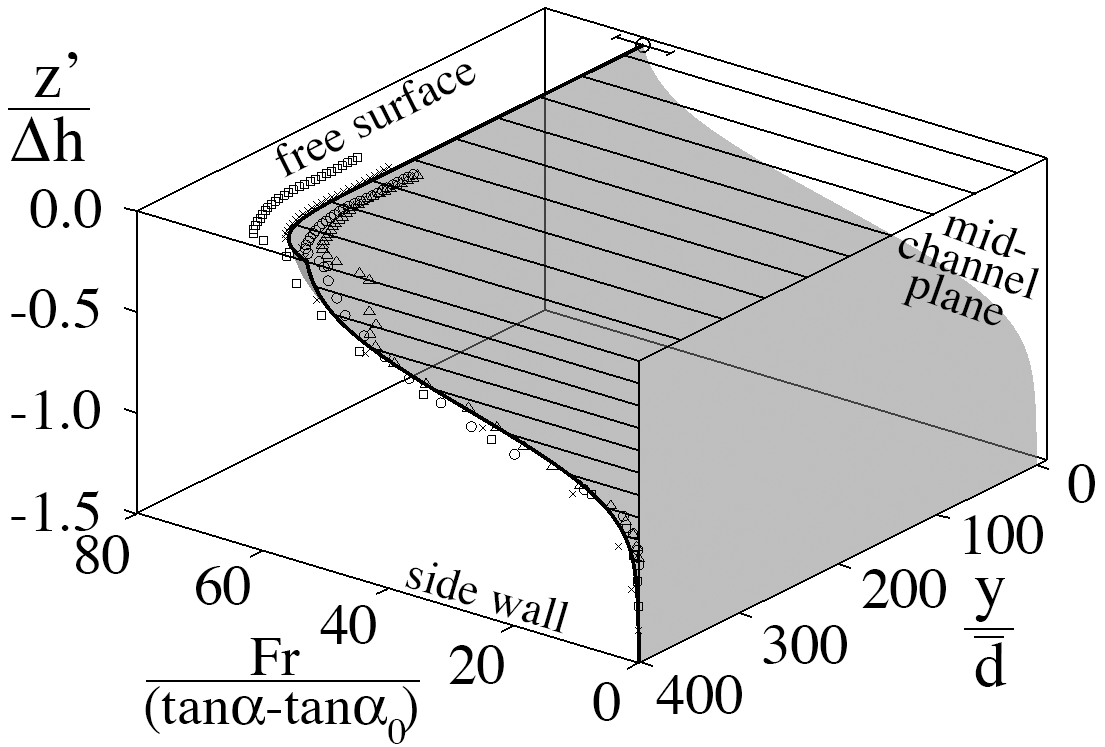
Profile of local dimensionless velocity over one half of the channel vs dimensionless lateral distance from the channel centerplane and vs dimensionless distance from the free surface.
M. Louge: “Phonon conductivity along a column of spheres in contact -- Relation to volume fraction invariance in the core of granular flows down inclines," Granular Matter, published online (2011).
This paper presents a simple model to calculate the "phonon"
conductivity and volume dissipation rate in dense granular flows where
grains remain in ephemeral contact with several other grains at once,
likely along a chain aligned with the major principal axis of stress.
We show that, unlike conductivity derived by kinetic theories of
granular gases, phonon conductivity is invariant with depth, thus
resolving the paradox of invariant solid volume fraction in the core of
dense granular flows down bumpy inclines, which arise upon applying
generic kinetic theories.
This paper is part of a
Special Issue of Granular Matter, edited by Thorsten Poschel and Dietrich Wolf, in memory
of our prolific colleague Isaac Goldhirsch (1949-2010), whose friendly and genial personality is sorely missed.
M. Louge: “Model for dense granular flows down bumpy inclines,” Phys. Rev. E 67, 061303 (2003).
This paper presents a simple model for dense steady, fully-developed flows of spherical grains down an inclined plane with a bumpy base. This is an example of an agitated granular flow in which grains experience collisional interactions, as well as more enduring contacts involving several grains at once.
Accordingly, our model treats stresses as the superposition of a
rate-dependent contribution arising from collisional interactions and a
rate-independent part related to enduring frictional contacts among the
grains. We show that dense flows consist of three regions. The first is
a thin "basal layer" where grains progressively gain fluctuation energy
with increasing distance from the bottom boundary. The second is a
"core" region, where the solid volume fraction is constant and the
production and dissipation of fluctuation energy are nearly balanced.
The last is a thin collisional "surface layer" where the volume
fraction abruptly vanishes as the free surface is approached.
We also distinguish basal flows with the smallest possible height,
in which the core and surface layers have disappeared. We derive simple
closures of the governing equations for the three regions
with insight from the numerical simulations of Silbert et al. [Phys.
Rev. E 64, 051302 (2001)] and the physical experiments of Pouliquen
[Phys. Fluids 11, 542 (1999)]. The theory captures the range of
inclination angles at which steady, fully developed flows are observed,
the corresponding shape of the mean and fluctuation velocity profiles,
the dependence of the flow rate on inclination, flow height,
interparticle friction, and normal restitution coefficient, and the
dependence of the height of basal flows on inclination.
A version of Louge (2003) is available here.

Sketch of the three regions in inclined flows down bumpy surfaces.
R. Delannay, M. Louge, P. Richard, N. Taberlet, A. Valance: “Towards a theoretical picture of dense granular flows down inclines,” Nature Materials 6, 99-108 (2007).
This review article surveys recent advances in experiments, numerical simulations and theories on inclined granular flows.
M. Louge and S. Keast: “On Dense Granular Flows Down Flat Frictional Inclines,” Phys. Fluids 13, 1213-1233 (2001).
This paper reports experiments on dense, relatively shallow flows of
3 mm glass spheres moving down a chute with a flat, frictional base of
3.6 m length. Sustained flows are observed at inclinations
corresponding to an effective friction between the static and dynamic friction of individual
grains.
A capacitance
instrument records the formation of waves with a
dominant component traveling upstream. Simultaneous measurements of
granular temperature at the base using a load cell reveal that the
waves are accompanied by substantial reduction in granular agitation.
A theory incorporating contributions from enduring and impulsive interactions with the flat base produces quantitative predictions for the range of sustained flows observed in the experiments. Closure of the theory is achieved using a balance between the production and dissipation of angular momentum in a narrow basal shear layer. The theory incorporates results for granular spin and boundary conditions established by Louge and Jenkins. A linear stability analysis of the corresponding hydraulic equations further suggests the origin of the waves.
A Matlab program that can be downloaded here can be used to implement the equations of the theory and predict the behavior of steady, fully-developed flows on a flat, frictional base.
An excerpt of Louge and Keast (2001) is available here.
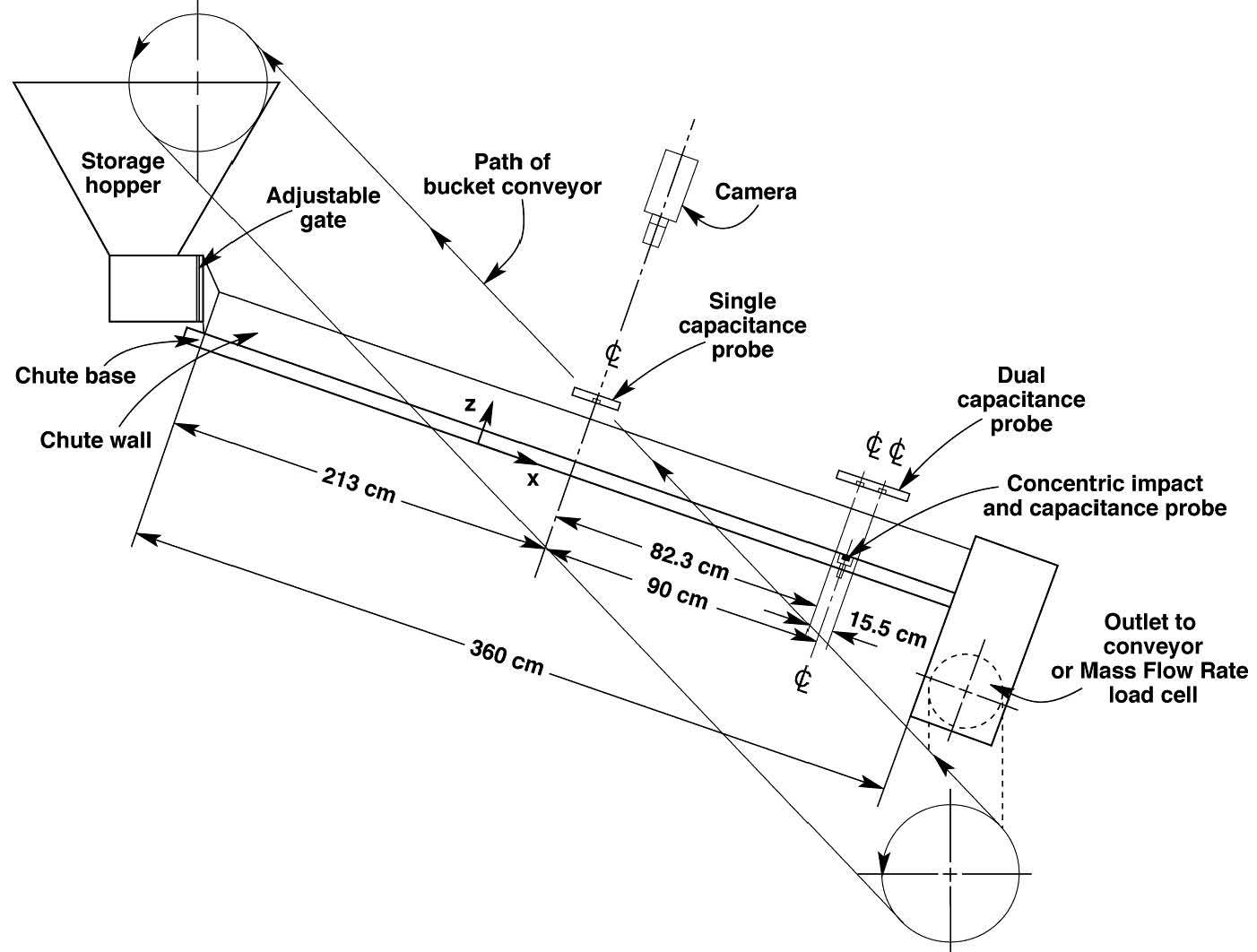
Sketch of Cornell's chute facility described by Louge and Keast (2001).
Left: Waves
of solids "holdup" are observed with our capacitance probe as they make
their way up the flat, frictional chute. As the mass flow rate m† is
increased, note the increase in the frequency of these waves. As we
later realized, the waves likely constitute a succession of relatively
shallow "SSH" flows, see Richard,
et al (2008).
P. Richard, A. Valance, J-F. Métayer, P. Sanchez, J. Crassous, M. Louge and R. Delannay: "Rheology of Confined Granular Flows: Scale Invariance, Glass Transition and Friction Weakening," Phys. Rev. Lett. 101, 248002 (2008).
As this movie shows, granular
flows confined between two flat, frictional side walls can be sustained
at an inclination steeper than the angle of repose. As the flow
disappears, so does the steeper slope. Our Rennes collaborators coined
the phrase "Side-wall Stabilized Heap" to describe such flow.
In this paper, we use experiments and numerical simulations to show
that the flows can be steady (i.e., time-invariant) and fully-developed
(i.e., invariant along the flow direction). Above a critical rate,
sidewall friction stabilizes the underlying heap at an inclination
larger than the angle of repose. The shear rate is constant and
independent of inclination over much of the flowing layer. In the
direction normal to the free surface, the solid volume fraction
increases on a scale equal to half the flowing layer depth. Beneath a
critical depth at which internal friction is invariant, grains exhibit
creeping and intermittent cage motion similar to that in glasses,
causing gradual weakening of friction at the walls.
Conference papers
M. Louge : « Role of Couple Stresses in Shallow Granular Flows down a Bumpy Incline, » 5th International Conference on Multiphase Flow, ICMF’04, Yokohama, Japan, May 30-June 4, 2004, Paper No.K13.
This paper present an analysis of inclined flows that accounts for couple stresses.
S. Keast and M. Louge : "On dense granular flow down flat, frictional inclines," IUTAM 2000 presentation.
This zipped file contains transparencies providing a simple account of the theory of Louge and Keast (2001).
The following papers provide additional information on confined flows in a SSH:
J-F. Métayer, R. Delannay, P. Richard, A. Valance and M. Y. Louge: "Rheology of confined granular flows: from gas to glass," Powders & Grains 2009, M. Nakagawa, ed. (2009).
M. Louge, A. Valance, N. Taberlet, P. Richard et R. Delannay, “Volume fraction profile in channeled granular flows down an erodible incline,” in Powders and Grains 2005, H.Herrmann, G. Gudehus, S. Luding, & K. Sommer (eds), A. Balkema, NY, pp. 885-889.
N. Taberlet, P. Richard, R. Delannay and M. Louge, “How sidewalls influence granular flows,” in Powders and Grains 2005, H.Herrmann, G. Gudehus, S. Luding, & K. Sommer (eds), A. Balkema, NY, pp. 873-876.
P. Richard, A. Valance, J.F. Métayer, J. Crassous, M. Louge, R. : « Rheology of confined granular flows », Joint IUTAM-ISIMM Symposium on Mathematical Modeling and Physical Instances of Granular Flows, Reggio Calabria, Italy, 14-18 September 2009.
Martian slides
Treiman, A.H., Louge, M.Y. (2004) Martian Slope Streaks and Gullies: Origins as Dry Granular Flows, 35th Lunar and Planetary Science Conference, March 15-19, 2004, League City, Texas, abstract # 1323.
In this work, we argue that Martian gullies are equally consistent with granular slides, as well as they are with more conventional theories involving a liquid. Greater detail is found in Allan H. Treiman (2003), Geologic settings of Martian gullies: Implications for their origins, J. Geophys. Res. 108, 8031, doi:10.1029/2002JE001900 and Troy Shinbrot, N.-H. Duong, L. Kwan, and M. M. Alvarez (2004) Dry granular flows can generate surface features resembling those seen in Martian gullies, PNAS 101, 8542-8546.

